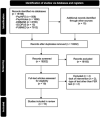Can the Ability to Recognize Facial Emotions in Individuals With Neurodegenerative Disease be Improved? A Systematic Review and Meta-analysis
- PMID: 37410880
- PMCID: PMC10683976
- DOI: 10.1097/WNN.0000000000000348
Can the Ability to Recognize Facial Emotions in Individuals With Neurodegenerative Disease be Improved? A Systematic Review and Meta-analysis
Abstract
Background: Facial emotion recognition (FER) is commonly impaired in individuals with neurodegenerative disease (NDD). This impairment has been linked to an increase in behavioral disorders and caregiver burden.
Objective: To identify interventions targeting the improvement of FER ability in individuals with NDD and investigate the magnitude of the efficacy of the interventions. We also wanted to explore the duration of the effects of the intervention and their possible impacts on behavioral and psychological symptoms of dementia and caregiver burden.
Method: We included 15 studies with 604 individuals who had been diagnosed with NDD. The identified interventions were categorized into three types of approach (cognitive, neurostimulation, and pharmacological) as well as a combined approach (neurostimulation with pharmacological).
Results: The three types of approaches pooled together had a significant large effect size for FER ability improvement (standard mean difference: 1.21, 95% CI = 0.11, 2.31, z = 2.15, P = 0.03). The improvement lasted post intervention, in tandem with a decrease in behavioral disorders and caregiver burden.
Conclusion: A combination of different approaches for FER ability improvement may be beneficial for individuals with NDD and their caregivers.
Copyright © 2023 The Author(s). Published by Wolters Kluwer Health, Inc.
Conflict of interest statement
The authors declare no conflicts of interest.
Figures




Similar articles
-
Eye-gaze Strategies During Facial Emotion Recognition in Neurodegenerative Diseases and Links With Neuropsychiatric Disorders.Cogn Behav Neurol. 2022 Mar 3;35(1):14-31. doi: 10.1097/WNN.0000000000000288. Cogn Behav Neurol. 2022. PMID: 35239596
-
The impact of intimate partner violence on facial emotion recognition among Korean baby boomers.Eur J Psychotraumatol. 2025 Dec;16(1):2474890. doi: 10.1080/20008066.2025.2474890. Epub 2025 Mar 26. Eur J Psychotraumatol. 2025. PMID: 40135447 Free PMC article.
-
Effectiveness of interventions that assist caregivers to support people with dementia living in the community: a systematic review.Int J Evid Based Healthc. 2008 Jun;6(2):137-72. doi: 10.1111/j.1744-1609.2008.00090.x. Int J Evid Based Healthc. 2008. PMID: 21631819
-
Screening for Cognitive Impairment in Older Adults: An Evidence Update for the U.S. Preventive Services Task Force [Internet].Rockville (MD): Agency for Healthcare Research and Quality (US); 2020 Feb. Report No.: 19-05257-EF-1. Rockville (MD): Agency for Healthcare Research and Quality (US); 2020 Feb. Report No.: 19-05257-EF-1. PMID: 32129963 Free Books & Documents. Review.
-
Dementia -- Caring, Ethics, Ethnical and Economical Aspects: A Systematic Review [Internet].Stockholm: Swedish Council on Health Technology Assessment (SBU); 2008 Jun. SBU Assessment No. 172. Stockholm: Swedish Council on Health Technology Assessment (SBU); 2008 Jun. SBU Assessment No. 172. PMID: 28876770 Free Books & Documents. Review.
Cited by
-
Tango and physiotherapy interventions in Parkinson's disease: a pilot study on efficacy outcomes on motor and cognitive skills.Sci Rep. 2024 May 24;14(1):11855. doi: 10.1038/s41598-024-62786-6. Sci Rep. 2024. PMID: 38789492 Free PMC article.
References
Publication types
MeSH terms
LinkOut - more resources
Full Text Sources
Medical

